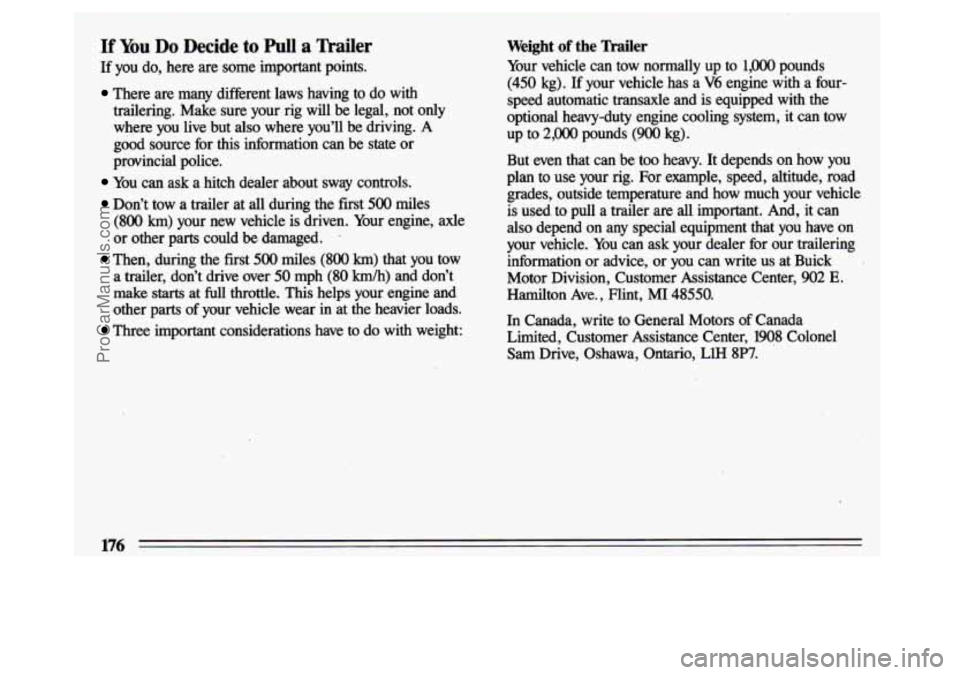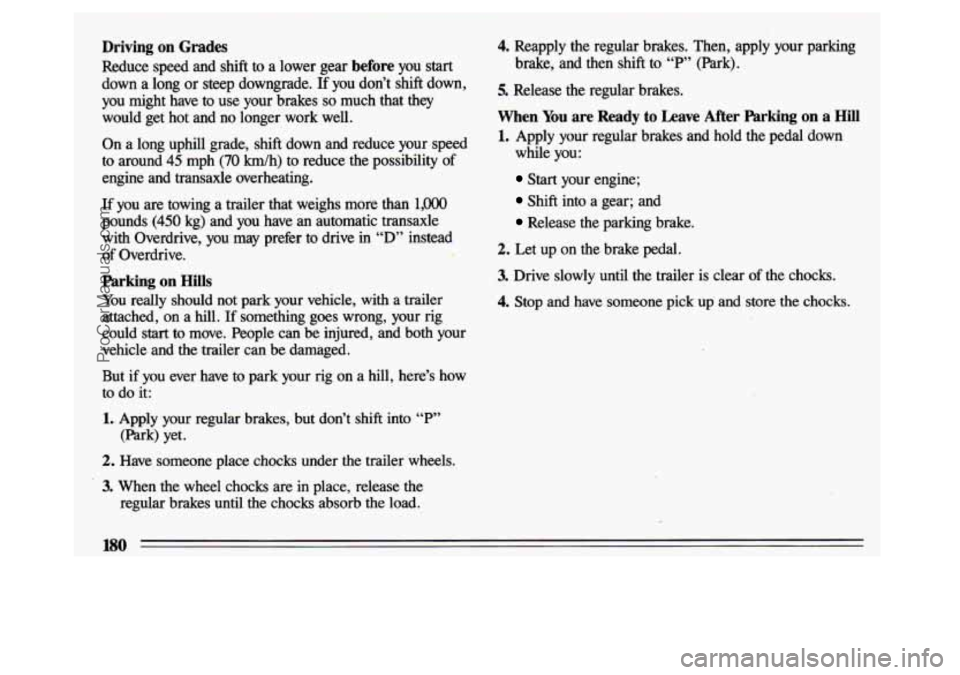Page 178 of 324

If You Do Decide to Pull a Trailer
If you do, here are some important points.
There are many different laws having to do with
trailering. Make sure your rig will be legal, not only where you live but also where you’ll be driving.
A
good source for this information can be state or
provincial police.
You can ask a hitch dealer about sway controls.
Don’t tow a trailer at all during the first 500 miles
(800 km) your new vehicle is driven. Your engine, axle
or other parts could be damaged. .
Then, during the first 500 miles (800 km) that you tow
a trailer, don’t drive over 50 mph (80 Wh) and don’t
make starts at full throttle. This helps your engine and
other parts of your vehicle wear
in at the heavier loads.
Three important considerations have to do with weight:
Weight of the Trailer
Your vehicle can tow normally up to 1,OOO pounds
(450 kg). If your vehicle has a V6 engine with a four-
speed automatic transaxle and is equipped with the
optional heavy-duty engine cooling system,
it can tow
up to 2,000 pounds
(900 kg).
But even that can be too heavy. It depends on how you
plan to use your rig. For example, speed, altitude, road grades, outside temperature and how much your vehicle
is used to pull
a trailer are all important. And, it can
also depend on any special equipment that you have on
your vehicle. You can ask your dealer for our trailering
information or advice, or you can write us at Buick
.
Motor Division, Customer Assistance Center, 902 E.
Hamilton Ave., Flint, MI 48550.
In Canada, write to General Motors of Canada
Limited, Customer Assistance Center, 1908 Colonel
Sam Drive, Oshawa, Ontario,
LlH 8W.
176
ProCarManuals.com
Page 182 of 324

Driving on Grades
Reduce speed and shift to a lower gear before you start
down a long or steep downgrade. If you don’t shift down,
you might have to use your brakes
so much that they
would get hot and no longer work well.
On a long uphill grade, shift down and reduce your speed
to around
45 mph (70 Mh) to reduce the possibility of
engine and transaxle overheating.
If you are towing a trailer that weighs more than 1,OOO
pounds (450 kg) and you have an automatic transaxle
with Overdrive, you may prefer
to drive in “D” instead
of Overdrive.
Parking on Hills
You really should not park your vehicle, with a trailer
attached, on a hill.
If something goes wrong, your rig
could
start to move. People can be injured, and both your
vehicle and the trailer can be damaged.
But if you ever have to park your rig on a hill, here’s how
to do it:
1. Apply your regular brakes, but don’t shift into “P”
2. Have someone place chocks under the trailer wheels. (Park) yet.
3. When the wheel chocks
are in place, release the
regular brakes until the chocks absorb the load.
4. Reapply the regular brakes. Then, apply your parking
5. Release the regular brakes.
When You are Ready to Leave After Parking on a Hill
1. Apply your regular brakes and hold the pedal down
brake, and then shift to
“P” (Park).
while you:
Start your engine;
Shift into a gear; and
Release the parking brake.
2. Let up on the brake pedal.
3. Drive slowly until the trailer is clear of the chocks.
4. Stop and have someone pick up and store the chocks.
ProCarManuals.com
Page 183 of 324
Maintenance When Trailer Towing
Your vehicle will need service more often when you’re
pulling a trailer. See the Maintenance Schedule for more
on this. Things that are especially important in trailer
operation
are automatic transaxle fluid (don’t overfill),
engine oil, belt, cooling. system, and brake adjustment.
Each of these is covered in this manual, and the Index
‘will help you find them quickly.
If you’re trailering, it’s a
good idea to review these sections before you
start your trip.
Check periodically
to see that all hitch nuts and bolts are
tight.
181
ProCarManuals.com
Page 185 of 324

I
Here you’ll find what to do about some problems that can occur on the road.
Part 5 includes:
HazardWarningFlashers ..............................................................184
Other Warning Devices . . . . . . . . . . . . . . . . . . . . . . . . . . . . . . . . . . . . . . . . . . . . . . . . . . . . . . . . . . . . . . .185
Jumpstarting
........................................................................\
..
Towing Your Buick . . . . . . . . . . . . . . . . . . . . . . . . . . . . . . . . . . . . . . . . . . . . . . . . . . . . . . . . . . . . . . . . . . .189
Engine Overheating
. . . . . . . . . . . . . . . . . . . . . . . . . . . . . . . . . . . . . . . . . . . . . . . . . . . . . . . . . . . . . . . . . .195
IfaTireGoesFlat
...................................................................205
ChangingaFlatTire ........................................,........................205
CompactSpareTire ..................................................................218
If You’re Stuck: In Sand, Mud, Ice or Snow . . . . . . . . . . . . . . . . . . . . . . . . . . . . . . . . . . . . . . . . . . . . . . .219
ProCarManuals.com
Page 188 of 324

‘
A CAUTION:
Mu could be injured if the vehicles roll. Set
the parking brake firmly
on each vehicle. Put
an automatic transaxle
in “P” (Park) or a
manual transaxle
in “N” (Neutral). I
3. ”urn off the igni;,,n on both vehicles. lwLLL all .,hts
that aren’t needed, and radios. This will avoid sparla
and help save both batteries. And it could save your radio!
If you leave your radio OI,, it could be badl,
4. Open the hoods and locate the batteries.
I 1
A CAUTION:
An electric fan can start up even when the
engine
is not running and can Injure you. Keep
hands, clothing and tools
away from any
underhood electric fan.
I
Find the positive (+) and negative (-) terminals on
each battery.
-
/1 CAUTION:
Using a match near a battery can cause
battery gas to explode. People have been hurt
doing this, and some have been blinded.
Use a
flashlight If you need more light.
Be sure the battery has enough water. Mu
don’t need to add water to the Delco
Freedom@ battery installed
in every new GM
vehicle. But if a battery has filler caps, be sure
the
right amount of fluid is there. If it is low,
add water to take care of that first. It you don’t,
explosive gas could be present.
Battery
fluid contains acid that can burn you.
Don’t get it on you. Ifyou accidentally get it in
your
eyes or on your skin, flush the place with
water and get medical help immediately.
-
5. Check that the jumper cables don’t have loose or missing insulation.
If they do, you could get a shock.
The vehicles could be damaged, too.
186
ProCarManuals.com
Page 189 of 324
Before you connect the cables, here are some basic things
you should know. Positive
(+) will go to positive (+) and
negative
(-) will go to negative (-) or a metal engine
part. Don’t connect
(+) to (-) or you’ll get a short that
would damage the battery and maybe other
parts, too.
/r CAUTION:
Fans or other moving engine parts can lnjum
you badly; Keep your hands away fmm mwlng
parts once the englnes are running.
6. Connect the red positive (+) cable to the positive (+)
terminal of the vehicle with the dead battery. Use a
remote positive
(+) terminal if the vehicle has one.
187
-
ProCarManuals.com
Page 190 of 324
3'.
7. Don't let the other end touch metal. Connect it
to the positive (+)
terminal of the good
battery. Use a remote
positive
(+) terminal if
the vehicle has one.
8. Now connect the black negative
(-) cable to the
good battery's negative
(-) terminal.
Don't let the other end
touch anything until the
next step. The other end of
the negative cable
doesn't
go to the dead battery. It
goes to a heavy unpainted
metal part on the engine of
the vehicle with the dead
battery.
9. Attach the cable at least 18 inches (45 cm) away from
the dead battery, but not near engine parts that move.
The electrical connection is just
as good there, but
the chance
of sparks getting back to the battery is
much less.
10. Now start the vehicle with the good battery and run
U. Try to start the vehicle with the dead battery. the engine for a while.
If it won't start after a
few tries,
it probably needs
service.
ProCarManuals.com
Page 194 of 324
2. Position a 4 I' x 4 I' wood beam across sling chains with
spacer blocks contacting the forward extensions
of the
engine cradle.
3. Position the lower sling crossbar halfway between the
timber
and the lower edge of the fascia.
192
ProCarManuals.com